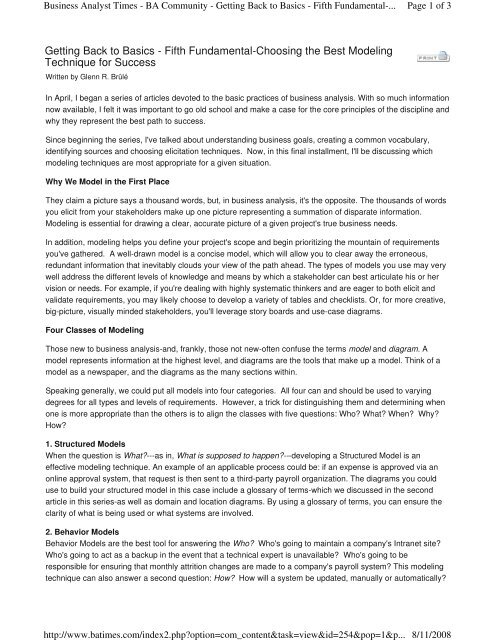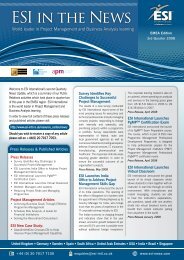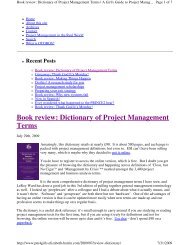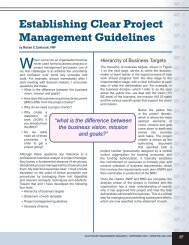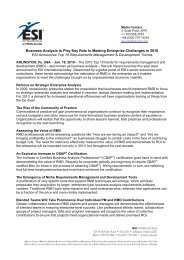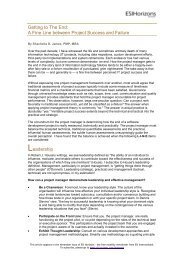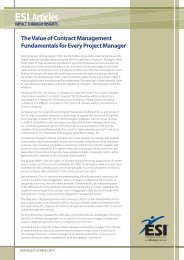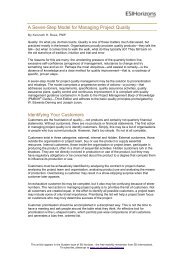Getting Back to Basics - Fifth Fundamental ... - ESI International
Getting Back to Basics - Fifth Fundamental ... - ESI International
Getting Back to Basics - Fifth Fundamental ... - ESI International
You also want an ePaper? Increase the reach of your titles
YUMPU automatically turns print PDFs into web optimized ePapers that Google loves.
Business Analyst Times - BA Community - <strong>Getting</strong> <strong>Back</strong> <strong>to</strong> <strong>Basics</strong> - <strong>Fifth</strong> <strong>Fundamental</strong>-...<br />
http://www.batimes.com/index2.php?option=com_content&task=view&id=254&pop=1&p...<br />
Page 1 of 3<br />
8/11/2008<br />
<strong>Getting</strong> <strong>Back</strong> <strong>to</strong> <strong>Basics</strong> - <strong>Fifth</strong> <strong>Fundamental</strong>-Choosing the Best Modeling<br />
Technique for Success<br />
Written by Glenn R. Brûlé<br />
In April, I began a series of articles devoted <strong>to</strong> the basic practices of business analysis. With so much information<br />
now available, I felt it was important <strong>to</strong> go old school and make a case for the core principles of the discipline and<br />
why they represent the best path <strong>to</strong> success.<br />
Since beginning the series, I've talked about understanding business goals, creating a common vocabulary,<br />
identifying sources and choosing elicitation techniques. Now, in this final installment, I'll be discussing which<br />
modeling techniques are most appropriate for a given situation.<br />
Why We Model in the First Place<br />
They claim a picture says a thousand words, but, in business analysis, it's the opposite. The thousands of words<br />
you elicit from your stakeholders make up one picture representing a summation of disparate information.<br />
Modeling is essential for drawing a clear, accurate picture of a given project's true business needs.<br />
In addition, modeling helps you define your project's scope and begin prioritizing the mountain of requirements<br />
you've gathered. A well-drawn model is a concise model, which will allow you <strong>to</strong> clear away the erroneous,<br />
redundant information that inevitably clouds your view of the path ahead. The types of models you use may very<br />
well address the different levels of knowledge and means by which a stakeholder can best articulate his or her<br />
vision or needs. For example, if you're dealing with highly systematic thinkers and are eager <strong>to</strong> both elicit and<br />
validate requirements, you may likely choose <strong>to</strong> develop a variety of tables and checklists. Or, for more creative,<br />
big-picture, visually minded stakeholders, you'll leverage s<strong>to</strong>ry boards and use-case diagrams.<br />
Four Classes of Modeling<br />
Those new <strong>to</strong> business analysis-and, frankly, those not new-often confuse the terms model and diagram. A<br />
model represents information at the highest level, and diagrams are the <strong>to</strong>ols that make up a model. Think of a<br />
model as a newspaper, and the diagrams as the many sections within.<br />
Speaking generally, we could put all models in<strong>to</strong> four categories. All four can and should be used <strong>to</strong> varying<br />
degrees for all types and levels of requirements. However, a trick for distinguishing them and determining when<br />
one is more appropriate than the others is <strong>to</strong> align the classes with five questions: Who? What? When? Why?<br />
How?<br />
1. Structured Models<br />
When the question is What?---as in, What is supposed <strong>to</strong> happen?---developing a Structured Model is an<br />
effective modeling technique. An example of an applicable process could be: if an expense is approved via an<br />
online approval system, that request is then sent <strong>to</strong> a third-party payroll organization. The diagrams you could<br />
use <strong>to</strong> build your structured model in this case include a glossary of terms-which we discussed in the second<br />
article in this series-as well as domain and location diagrams. By using a glossary of terms, you can ensure the<br />
clarity of what is being used or what systems are involved.<br />
2. Behavior Models<br />
Behavior Models are the best <strong>to</strong>ol for answering the Who? Who's going <strong>to</strong> maintain a company's Intranet site?<br />
Who's going <strong>to</strong> act as a backup in the event that a technical expert is unavailable? Who's going <strong>to</strong> be<br />
responsible for ensuring that monthly attrition changes are made <strong>to</strong> a company's payroll system? This modeling<br />
technique can also answer a second question: How? How will a system be updated, manually or au<strong>to</strong>matically?
Business Analyst Times - BA Community - <strong>Getting</strong> <strong>Back</strong> <strong>to</strong> <strong>Basics</strong> - <strong>Fifth</strong> <strong>Fundamental</strong>-...<br />
http://www.batimes.com/index2.php?option=com_content&task=view&id=254&pop=1&p...<br />
Page 2 of 3<br />
8/11/2008<br />
How will progress be reported up the food chain, by e-mail or directly during conference calls?<br />
As the name indicates, we're dealing with human behavior here, and, in the workplace, that usually translates <strong>to</strong><br />
individual roles and responsibilities. Therefore, diagrams include behavior categories as well as process maps<br />
and use-case maps. Also, when creating a behavior model, don't forget your stakeholder categories, which we<br />
discussed in detail in the third article in this series.<br />
3. Control Models<br />
Now, on <strong>to</strong> my three-year-old son's favorite question: Why? Control Models tend <strong>to</strong> focus most successfully on<br />
justifying why something needs <strong>to</strong> be done, or why it is valuable <strong>to</strong> do something a certain way. And, quite often,<br />
the answers can be found in the business policies and rules that you've collected throughout elicitation. An<br />
organization's individual policies, for better or worse, often determine the course of a project. For example:<br />
When an associate project manager makes a purchase request in excess of $10,000, that request will<br />
au<strong>to</strong>matically bypass his or her direct boss and be sent <strong>to</strong> the head of the division. Why does this have <strong>to</strong> be<br />
done? Because, those are the rules, kiddo.<br />
4. Dynamic Model<br />
Finally, Dynamic Models, although not used as often as the other classes, are all about When? When will reports<br />
be generated? When will the first stage of the project be completed? When is this article due <strong>to</strong> BA Times?<br />
Dynamic Models will be made up of your most time-driven diagrams, which may include event tables or detailed<br />
timelines.<br />
Best of Luck<br />
And with that, our whirlwind back-<strong>to</strong>-the-basics <strong>to</strong>ur has come <strong>to</strong> an end. I wish you luck in your future<br />
endeavors, and hope that you remember the value of our discipline's basic best practices.<br />
If, for some reason, you missed any of the four previous articles, don't worry. The film version of the series<br />
starring George Clooney will be hitting theaters worldwide this fall!<br />
Glenn R. Brûlé has more than 18 years' experience in many facets of business, including project management,<br />
business analysis, software design and facilitation. At <strong>ESI</strong>, he is responsible for supporting a global team of<br />
business consultants working with Fortune 1000 organizations. These engagements focus on understanding,<br />
diagnosing and providing workable business solutions <strong>to</strong> complex problems across various industries. Glenn was<br />
formerly a Direc<strong>to</strong>r at Large for the <strong>International</strong> Institute of Business Analysis (IIBA) where he was responsible<br />
for forming local chapters of the IIBA around the world.<br />
Hits: 556<br />
Email This<br />
Bookmark<br />
Set as favorite<br />
Comments (1)<br />
Subscribe <strong>to</strong> this comment's feed<br />
...<br />
written by dallen, August 05, 2008<br />
Is it possible <strong>to</strong> provide examples of the different models you discuss? Thanks, Daryl Allen.<br />
Votes: +1 vote up vote down report abuse
Business Analyst Times - BA Community - <strong>Getting</strong> <strong>Back</strong> <strong>to</strong> <strong>Basics</strong> - <strong>Fifth</strong> <strong>Fundamental</strong>-...<br />
http://www.batimes.com/index2.php?option=com_content&task=view&id=254&pop=1&p...<br />
Page 3 of 3<br />
8/11/2008<br />
Write comment<br />
Close Window


